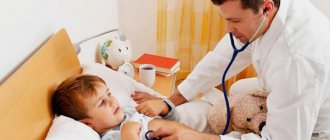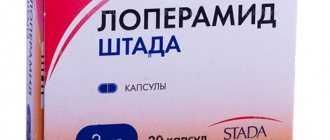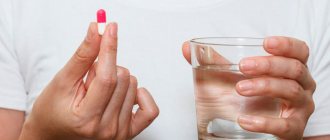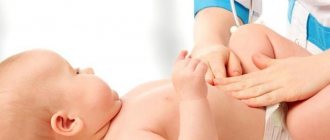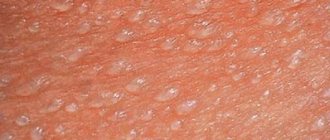Children are more susceptible to rotavirus infection. Their disease progresses severely and often with complications, in particular, dysbiosis and dehydration. After an infection, digestive problems and diarrhea are often observed. To normalize the condition, it is important to promptly begin to restore health in children after rotavirus infection.
Recovery after rotavirus infection
Rotavirus infection lasts on average 7-8 days, but complete recovery takes weeks and sometimes months .
To restore a child, you need to understand the pathogenetic mechanisms of the development of the disease and take the necessary measures accordingly. In this regard, recovery will speed up :
- restoration of fluid loss;
- diet and nutrition;
- combating the consequences of the virus.
The first step is to normalize the water-electrolyte balance . Since rotavirus infection causes dyspepsia in the form of vomiting and repeated diarrhea, important microelements and fluid are lost, which leads to dehydration. For rehydration, use special solutions or drinks prepared at home.
For recovery purposes, you can purchase from pharmacies:
- Regidron,
- Hydrovit,
- Trihydron,
- Citraglucosolan,
- Reosalan.
You can prepare a similar drink at home:
- 1 tsp. salt,
- 4 tsp. Sahara,
- 0.5 tsp. baking soda,
- 1 liter of boiled water.
Lemon, ginger or raisin decoction are added for taste . If possible, the child should take this drink in small sips every 15 minutes, in severe cases - after 5 minutes.
Important! Syrups, compotes, teas with a high sugar content are not recommended, since the high glycemia of these drinks can harm a dehydrated body.
Diet therapy should be gentle, since the intestines are very sensitive after the virus.
The list of “correct” dishes includes:
- porridge on the water,
- lean meat,
- cottage cheese and kefir,
- bread crumbs,
- vegetables and fruits, with the exception of citrus fruits.
You should not force your child to eat. When the intoxication passes, your appetite will resume, only then you need to establish a diet.
Sorbents are prescribed to combat diarrhea:
- Activated carbon,
- "Enterosgel"
- "Smectu".
They bind pathogens, their toxins and inflammatory products, thus reducing intoxication . If the virus has damaged the enzyme systems of the pancreas, diarrhea will continue. To do this, you need to take multienzyme drugs (Creon, Pancreatin). Dysbacteriosis can be removed with the help of probiotics (Acidolac, Linex).
To restore the regulation of the gastrointestinal tract, prokinetics (Metoclopramide, Cerucal) can be used. They minimize vomiting and nausea.
Rotavirus in children
Signs of the disease in children are pronounced, and from the first days of the development of the disease:
- the child does not eat anything;
- he is vomiting;
- the child is lethargic, sleepy, restless, does not want to go for walks
- there is a rash on the skin;
- the stool changes consistency and color: on the first day it is yellow and liquid, on the second and subsequent days it is yellow-gray.
Possible complications and consequences
The course of the disease in most cases is moderate. With the right treatment tactics, complications do not occur, but sometimes the infection becomes life-threatening for the child.
Why is it dangerous?:
- severe dehydration;
- acetonemic syndrome;
- convulsions;
- neurological disorders (neurotoxicosis);
- acute renal failure;
- diarrhea or constipation;
- asthenic syndrome;
- cough;
- repeated rotavirus.
Such complications occur more often in children from 6 months to a year or in older children with impaired immune system function. A rotavirus infection can be accompanied by bacterial pathogenic microflora, which also aggravates the course of the disease and can cause severe toxicosis with exicosis (reduction in the required amount of fluid in the tissues).
Stomach ache
As a rule, after rotavirus the child has a stomach ache. The most common cause of pain in the epigastric region is dysbiosis .
Disruption of normal microflora and its replacement by pathogenic microflora leads to the accumulation of gases in the abdomen. It is not worth giving painkillers or antispasmodics - they will not be able to remove the cause, but will only blur the clinical picture and subsequent diagnosis of complications.
Depending on the location of the pain and the child’s complaints, the doctor may prescribe:
- means for relieving attacks of intestinal colic;
- herbal decoctions or mineral water;
- sorbents;
- oral rehydration solutions.
If the pain is accompanied by:
- vomit,
- heat,
- diarrhea with bloody impurities,
you need to seek medical help. You should also not delay if the pain does not go away within 30 minutes after home treatment.
It is much more dangerous if the cause of pain is pancreatitis . It develops against the background of a virus affecting the digestive system.
With this disease, the child experiences:
- severe pain of a girdle nature,
- repeated vomiting and diarrhea,
- Purple spots may appear on the abdomen.
In such cases, a mandatory consultation with a doctor is necessary.
Loose stools
After an infection, stool can be restored within a week, sometimes up to a month . The damaged mucous membrane needs time to restore its structure and normalize its function.
Meals during this period should be frequent and fractional, in small portions. As little as possible dairy products, fresh vegetables and fruits, especially apples.
Important! Since it is difficult for enzymes to activate in an environment with damaged intestines, it is therefore advisable to take Creon or Linex according to the instructions.
The cause of prolonged diarrhea is also dysbacteriosis . When the mucous membrane is restored, the intestinal microflora is normalized, bacteria will begin to perform their functions and diarrhea will stop. Probiotics are prescribed as an adjuvant.
If in older children this condition is corrected with the help of diet and certain medications, it is much more difficult to deal with diarrhea in children under 1 year of age.
Against the background of rotavirus infection and after it, some children may develop secondary lactase deficiency . This means that the body cannot process milk (lactose), which makes up almost 100% of the child’s diet.
The stool is usually clear, yellowish-white, and often foamy. May occur without previous stimulation. Such children gain weight poorly, lose it, and lag behind in development. They are very restless and weak, and often suffer from colds.
In the treatment of secondary lactase deficiency, it is important:
- dieting,
- the use of enzyme preparations and probiotics,
- symptomatic treatment (for example, against flatulence).
But another important factor is time. As a child develops with a proper diet, the body's enzyme systems are formed, and the diet becomes less dependent on milk and at an older age, dairy products are normally absorbed.
Weakness and lethargy
Even the mildest degree of the disease weakens the body . Since the virus affects the respiratory and intestinal tissues of the organs, children are very exhausted during recovery. Dehydration also leads to general weakness. Intoxication and accumulation of toxins from the pathogen poison the body and thereby weaken it.
At the height of the illness, the child is usually lethargic, may refuse to eat, and the food that enters the body is processed very slowly. The reason for this is that the infection slows down metabolic processes, since at this time all resources are aimed at fighting the disease . Metabolic processes in the synapses of neurons slow down in a similar way, which is clinically manifested by lethargy, drowsiness and weakness.
In severe cases of the disease, weakness can develop into asthenic syndrome . Asthenia, unlike ordinary fatigue, does not subside even after long-term sleep or prolonged rest, lasts longer and requires mandatory treatment.
To restore the child you need:
- normalize the regime and diet high in vitamins and proteins;
- include light physical activity (exercise) in the mode;
- massage;
- do not neglect walks in the fresh air (including before bedtime);
- it is enough to stay in the sun;
- phytotherapy.
These recommendations focus on three main points that are important for combating weakness after illness:
- proper nutrition,
- restoration of muscle tone,
- relaxation of the nervous system.
If after 2-3 weeks the child remains lethargic and tired, you should consult a specialist.
Constipation
Constipation (stool retention) is a common consequence of infection. Constipation can be caused by the disease itself or its treatment.
Causes of constipation:
- penetration of antibodies into the intestinal mucosa . Since rotavirus is sensitive to receptors for milk-processing enzymes, they provoke antibodies to fight them, destroying the intestinal mucosa. Thus, it cannot function properly and process food;
- inflammatory processes . As a result of illness or subsequent dysbiosis, enterocolitis occurs. The intestinal wall cannot conduct elements and water, as a result of which feces remain in the lumen of the organ;
- disruption of enzyme systems . They are disrupted when the pancreas and duodenum are affected, and less commonly the liver. They contain hormones that, under the influence of food, stimulate the production and release of enzymes. In their absence, food is not processed and remains unchanged.
Clinically, constipation is manifested by the absence of stool with normal nutrition . And if it appears, the stool will be dry and hard. Children will complain of stomach pain and bloating.
In such cases, it is necessary to remove the cause of the pathological condition. If this is inflammation, you need to:
- stick to a strict diet,
- continue to replenish the fluid level,
- take sorbents.
Antibiotic therapy is not appropriate in this case, because these drugs do not act on the virus and can aggravate dysbiosis.
When it comes to enzymopathies, you cannot do without multienzyme drugs . They should be prescribed by a doctor according to the age and weight of the child.
In addition, if antidiarrheals are used incorrectly, constipation may occur. In such cases, the use of these drugs should be discontinued. There is no need to change your diet.
How to treat intestinal flu
Currently, there is no remedy aimed at treating rotavirus infection directly, so the therapeutic course for patients is complex.
Rehydration
The specific manifestations of the disease are such that the body suffers from dehydration: during diarrhea and vomiting, liquid is removed from the body in large quantities. Therefore, an important point in treatment is rehydration - replenishment of lost fluid. The most effective drug for these purposes is Regidron.
In order not to provoke new attacks of vomiting, in the acute period of the disease the liquid should be taken in very small portions, up to a teaspoon.
Important! If the process of dehydration continues for more than a day, and taking even small portions of water causes vomiting, intravenous fluid administration is required in a hospital setting.
Sorbents
To remove toxins from the body, sorbents are used - special preparations that bind and remove waste products of a spherical pathogen: Smecta, Enterosgel, Polysorb.
Tidy up your intestines
- During the treatment of the disease, restoration of the intestinal microflora is required. Starting from the 3-4th day of illness, it is recommended to take the following medications: “Normobakt”, “Bifidumbacterin”, “Linex”.
- Against the background of the disease, pathogenic flora often develops in the intestines. To prevent this, the drugs Enterefuril and Enterol are prescribed.
Antiviral therapy
Unfortunately, there is no drug that specifically targets rotavirus. To alleviate the course of the disease, it is advisable to use antiviral drugs that prevent further penetration of the pathogen into cells and thereby shorten the duration of the disease: “Tsitovir 3”, “Viferon”, “Arbidol”, “Anaferon”.
Auxiliary agents in the treatment of rotavirus
- For frequent, uncontrollable vomiting, antiemetics, for example, Motilium, will help.
- If the disease is accompanied by a high temperature, antipyretic medications are used: Panadol, Cefekon, Ibuprofen, Nurofen. Elevated temperature is a protective reaction of the body: its increase above 38 degrees has a detrimental effect on viruses. Therefore, you should not lower the temperature below 38.5.
Important! Rotavirus is insensitive to antibacterial agents. Treating it with antibiotics is not only pointless, but also harmful. Drugs in this group will further increase the bacterial imbalance of the intestine, thereby facilitating the further spread of the virus.
Antibacterial drugs are prescribed if a bacterial infection has developed against the background of the disease. This situation can occur no earlier than on the 3-4th day of illness and is confirmed by special tests.
Can your baby get sick again?
A previous infection does not make the body resistant to it in the future . Type-specific immunity develops, and since there are several serological types of rotavirus, the likelihood of re-infection is very high.
The immune system is very weak, so the same type of virus can cause re-infection after a short period of time . Nevertheless, each time the disease is tolerated more easily, so repeated rotavirus passes with less pronounced symptoms.
Relapse of rotavirus usually occurs in infants 3-4 months after the disease. The main thing in preventing the recurrence of the disease is identifying the source of the disease and isolating it.
Symptoms of intestinal flu in adults
An adult suffers from this disease much easier. His symptoms are not so clearly expressed. In some cases, the disease does not show any symptoms at all. In an adult, the disease can be recognized by the following symptoms:
- lack of appetite;
- my stomach hurts;
- diarrhea;
- light-colored stool, foamy and abundant, with the presence of undigested food, a pungent and sour odor.
Vomiting in an adult most often does not occur at all. As you can see, the symptoms of intestinal flu can be easily confused with traditional poisoning. Therefore, it is very important to understand the reasons for the appearance of these symptoms, and if the diagnosis confirms the presence of the infection in question, then it is very important to know how to properly treat the disease, and even more important, how to recover from rotavirus infection.
Normal poisoning lasts no longer than three days, rotavirus infection lasts up to five days, and sometimes up to eight.
What mothers should pay attention to
Mothers complain of child lethargy after rotavirus. A balanced diet, vegetables, fruits rich in vitamins, and fresh air help to recover.
I’m interested in what day is it permissible to wash. It is necessary to wipe the child with a damp towel in the first days of illness, when the high temperature does not allow swimming. After the temperature subsides, it is permissible to wash in the bathroom or take a shower.
Moms ask about walking with rotavirus. It is easily transmitted to others - the sick person is isolated from healthy children, provided with individual utensils and hygiene items. Take a closer look at how the child recovers from an illness and at his nutritional habits.
The condition improves on days 3-5, the temperature drops, and the baby is bathed. You should not have contact with healthy children; avoid going for walks.
10-15 days after the onset of the disease, intestinal function normalizes, the child becomes active and begins to eat. It is permissible to walk outside, not forgetting about hand hygiene: immunity to rotavirus is not developed, and there is a possibility of relapse.
You should refrain from going to the bathhouse or public places with your child to avoid infecting others. The baby's room and used areas are disinfected.
Among all intestinal infections, the most common and dangerous for young children is rotavirus infection. As many as 6% of all deaths in children under one year of age occur due to infection with this virus; a significant number of complications and a relatively high risk of infection suggest the need to disseminate information about this disease. The ability to quickly recognize rotavirus and understand the severity of the current situation can save a person’s life.
Rotavirus infection gets its name from the Latin “rota” - wheel, due to the structure of the virus like a wheel with spokes. That is why the concept of rotovirus, found in some sources of information, does not exist as such. This microorganism is an RNA virus surrounded by two protein shells to protect it from environmental factors and allow it to pass through the gastric barrier into the small intestine.
This infection is widespread and occurs at any time of the year; infectious disease specialists note a slight increase in incidence in the cold season, due to its good resistance to low temperatures.
The disease can only be spread by a patient with gastroenteritis along with excreted feces; the main route of transmission is contact, however, when traces of feces get on food or in water, these routes are also realized. Recently, the possibility of an airborne droplet mechanism has been suggested during the period of catarrhal phenomena.
Once in the digestive tract, the infection quickly, within several hours, reaches the small intestine, where, penetrating into the epithelium of the villi, the pathogen begins to multiply intensively. Just 20 hours after infection, massive damage to the intestinal villi develops, which leads to disruption of parietal digestion. The transiting nutrients reach the large intestine, where, due to their osmotic activity, they prevent the reabsorption of water into the bloodstream, which provokes diarrhea.
The increased permeability of the damaged intestine is not able to retain the virus within the digestive system and viremia occurs almost immediately, free circulation of rotavirus in the blood causes fever, and due to its affinity for the epithelial tissue of the nasopharynx, catarrhal phenomena in the form of a sore throat and runny nose are not long in coming .
After a rotavirus infection, there is no full-fledged and long-lasting immunity, which leaves the possibility of re-transmitting the full-fledged form of intestinal flu again and again.
The immaturity of intestinal villi in newborns and infants, as well as low body weight, explains the rapid course of the disease and the possibility of serious dehydration, in contrast to the relatively mild course of rotavirus infection in adults. Only weakened immunity associated with bone marrow transplantation, radiation, acquired or congenital immunodeficiencies can cause the development of life-threatening complications.
How does the disease progress?
Despite the fact that rotavirus is considered an intestinal infection, it begins to infect the human body from the upper respiratory tract. It is observed more often in children under 5 years of age. It is during this period that the immune system is easily exposed to the virus, which is why children get this disease more often than adults. Rotavirus affects the mucous membranes of the intestines, stomach and duodenum, causing disorders and dehydration.
The virus, entering the child’s body, may not manifest itself in any way during the first 5 days (incubation period). Afterwards comes the stage of exacerbation and during this period the first signs begin to appear. The child begins to worry and cry for no apparent reason. It gets especially bad for him on the first day.
The pathogens are released along with the feces, so the sick person is considered a carrier of infection to all family members and others.
This lasts for a week and only after this period does it cease to be contagious. After treatment, recovery from rotavirus infection in children is required. Only after this can the child be released to school or kindergarten, but provided that he does not experience a relapse.
Treatment of a child
It is worth talking about the treatment of a child separately, since children are much more susceptible to the disease.
Children begin to experience the disease with attacks of vomiting, sometimes multiple times. Also, in most cases, the child is lethargic and sleepy. As a rule, vomiting begins at night.
Then the body temperature rises to thirty-nine degrees and above.
It is worth saying that at a body temperature of thirty-nine degrees, call emergency help, since the temperature with rotavirus is difficult to reduce with antipyretics. With severe vomiting and diarrhea, the child quickly becomes dehydrated.
Stool upset begins, cramping or constant pain in the abdomen occurs, accompanied by rumbling. The stool is mostly foamy with an unpleasant sour odor and yellow or light in color.
Vomiting and diarrhea accompanied by an elevated temperature can lead to dehydration.
- No urination for more than two hours;
- Crying without releasing tears;
- Lethargy, for falling eyes;
- Cloudiness of consciousness;
- The temperature does not decrease after taking medications for it;
- Heart problems;
- Convulsions are possible.
In serious condition, the baby is hospitalized in a hospital. Where treatment is carried out by restoring the water-salt balance through droppers and treating associated symptoms.
How to reduce fever with rotavirus:
- For children, the most effective remedy for fever is paracetamol in the form of suppositories, which is especially effective for repeated vomiting;
- Rubbing with a water-vodka solution;
- Do not wrap the baby.
Help with vomiting:
- In case of repeated vomiting, antiemetics are used in ampoules, vomiting stops after half an hour (Cirukal);
- Regidron - restores water-salt balance;
At home, to urgently help a child, if you don’t have Regidron in your medicine cabinet, you can make an analogue of a water-salt solution: take a tablespoon of sugar and a teaspoon of salt per liter of boiled water. Stir, drink one tablespoon every fifteen minutes. You must consume at least two hundred milliliters of solution per day.
- Among the folk remedies, decoctions of medicinal herbs perfectly relieve gagging and reduce inflammation of the mucous membranes: chamomile, ginger root.
Or, freshly squeezed orange juice is a great way to help with dehydration.
For severe diarrhea use:
- Preparations based on nifuroxazide (Enterofuril, Stopdiar);
- Medicines based on unicellular yeast fungi of the order Saccharomycetes (Enterol);
- Semiticon-based products (Smecta, Neosmectin);
- From folk remedies: bird cherry, oak bark.
Get rid of toxins
Recovery from rotavirus infection in adults and children will go much faster if you take care of timely cleansing of the body from harmful toxins. For this purpose, the doctor prescribes special sorbents. These include:
- Smecta;
- Enterosgel;
- Activated carbon, familiar to everyone.
These drugs bind toxins and remove them. At the same time, digestion and normal functioning of the body are restored and improved.
Preventive actions
First of all, treat the apartment with a disinfectant, strictly monitor personal hygiene, wash your hands:
- before and after meals;
- before and after going to the toilet;
- upon returning home from the street.
In addition to hygiene, you need to monitor the freshness, cleanliness and quality of food - apples, for example, should not just be wiped, but washed. Treat toys if there are several children and one of them is sick.
Buy dairy products fresh and in stores, not at random outlets.
Is it possible to get re-infected with the virus?
You can become infected after recovery and repeatedly. Children are more often infected. Then, as they grow older, their gastrointestinal tract becomes more resistant to bacteria. That's why adults get sick much less often than children. True, much depends on the body’s reserve forces and the individual characteristics of the digestive system.

